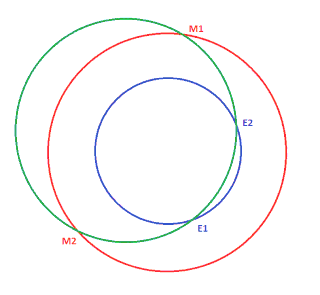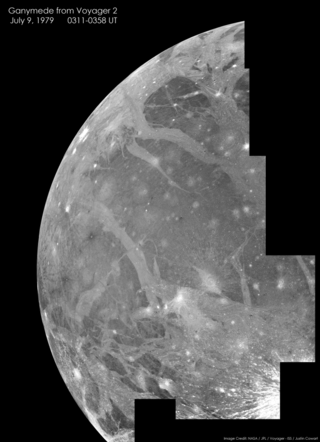
A cycler is a potential spacecraft on a closed transfer orbit that would pass close to two celestial bodies at regular intervals. Cyclers could be used for carrying heavy supplies, life support and radiation shielding.

A cycler is a potential spacecraft on a closed transfer orbit that would pass close to two celestial bodies at regular intervals. Cyclers could be used for carrying heavy supplies, life support and radiation shielding.
A free-return trajectory is a symmetrical orbit past the Moon and Earth that was first analysed by Arthur Schwaniger [1]
A lunar cycler or Earth–Moon cycler is a cycler orbit, or spacecraft therein, which periodically passes close by the Earth and the Moon, using gravity assists and occasional propellant-powered corrections to maintain its trajectories between the two. If the fuel required to reach a particular cycler orbit from both the Earth and the Moon is modest, and the travel time between the two along the cycler is reasonable, then having a spacecraft in the cycler can provide an efficient and regular method for space transportation. [2]
A Mars cycler or Earth–Mars cycler is a spacecraft trajectory that encounters the Earth and Mars on a regular basis, or a spacecraft on such a trajectory
An interstellar cycler or Schroeder cycler, a theoretical spacecraft trajectory that encounters two or more stars on a regular basis, or a spacecraft on such a trajectory

Interplanetary spaceflight or interplanetary travel is the crewed or uncrewed travel between stars and planets, usually within a single planetary system. In practice, spaceflights of this type are confined to travel between the planets of the Solar System. Uncrewed space probes have flown to all the observed planets in the Solar System as well as to dwarf planets Pluto and Ceres, and several asteroids. Orbiters and landers return more information than fly-by missions. Crewed flights have landed on the Moon and have been planned, from time to time, for Mars, Venus and Mercury. While many scientists appreciate the knowledge value that uncrewed flights provide, the value of crewed missions is more controversial. Science fiction writers propose a number of benefits, including the mining of asteroids, access to solar power, and room for colonization in the event of an Earth catastrophe.

Mars Direct is a proposal for a human mission to Mars which purports to be both cost-effective and possible with current technology. It was originally detailed in a research paper by Martin Marietta engineers Robert Zubrin and David Baker in 1990, and later expanded upon in Zubrin's 1996 book The Case for Mars. It now serves as a staple of Zubrin's speaking engagements and general advocacy as head of the Mars Society, an organization devoted to the colonization of Mars.

The Mariner program was conducted by the American space agency NASA to explore other planets. Between 1962 and late 1973, NASA's Jet Propulsion Laboratory (JPL) designed and built 10 robotic interplanetary probes named Mariner to explore the inner Solar System - visiting the planets Venus, Mars and Mercury for the first time, and returning to Venus and Mars for additional close observations.

Pioneer 10 is a NASA space probe launched in 1972 that completed the first mission to the planet Jupiter. Pioneer 10 became the first of five planetary probes and 11 artificial objects to achieve the escape velocity needed to leave the Solar System. This space exploration project was conducted by the NASA Ames Research Center in California. The space probe was manufactured by TRW Inc.

Spaceflight is an application of astronautics to fly objects, usually spacecraft, into or through outer space, either with or without humans on board. Most spaceflight is uncrewed and conducted mainly with spacecraft such as satellites in orbit around Earth, but also includes space probes for flights beyond Earth orbit. Such spaceflight operate either by telerobotic or autonomous control. The more complex human spaceflight has been pursued soon after the first orbital satellites and has reached the Moon and permanent human presence in space around Earth, particularly with the use of space stations. Human spaceflight programs include the Soyuz, Shenzhou, the past Apollo Moon landing and the Space Shuttle programs. Other current spaceflight are conducted to the International Space Station and to China's Tiangong Space Station.

A trans-lunar injection (TLI) is a propulsive maneuver, which is used to send a spacecraft to the Moon. Typical lunar transfer trajectories approximate Hohmann transfers, although low-energy transfers have also been used in some cases, as with the Hiten probe. For short duration missions without significant perturbations from sources outside the Earth-Moon system, a fast Hohmann transfer is typically more practical.

Aerobraking is a spaceflight maneuver that reduces the high point of an elliptical orbit (apoapsis) by flying the vehicle through the atmosphere at the low point of the orbit (periapsis). The resulting drag slows the spacecraft. Aerobraking is used when a spacecraft requires a low orbit after arriving at a body with an atmosphere, as it requires less fuel than using propulsion to slow down.

A gravity assist, gravity assist maneuver, swing-by, or generally a gravitational slingshot in orbital mechanics, is a type of spaceflight flyby which makes use of the relative movement and gravity of a planet or other astronomical object to alter the path and speed of a spacecraft, typically to save propellant and reduce expense.

Orbital mechanics or astrodynamics is the application of ballistics and celestial mechanics to the practical problems concerning the motion of rockets, satellites, and other spacecraft. The motion of these objects is usually calculated from Newton's laws of motion and the law of universal gravitation. Orbital mechanics is a core discipline within space-mission design and control.
Zond was the name given to two distinct series of Soviet robotic spacecraft launched between 1964 and 1970. The first series, based on the 3MV planetary probe, was intended to gather information about nearby planets.

The Interplanetary Transport Network (ITN) is a collection of gravitationally determined pathways through the Solar System that require very little energy for an object to follow. The ITN makes particular use of Lagrange points as locations where trajectories through space can be redirected using little or no energy. These points have the peculiar property of allowing objects to orbit around them, despite lacking an object to orbit. While it would use little energy, transport along the network would take a long time.

The Mars Climate Orbiter was a robotic space probe launched by NASA on December 11, 1998, to study the Martian climate, Martian atmosphere, and surface changes and to act as the communications relay in the Mars Surveyor '98 program for Mars Polar Lander. However, on September 23, 1999, communication with the spacecraft was permanently lost as it went into orbital insertion. The spacecraft encountered Mars on a trajectory that brought it too close to the planet, and it was either destroyed in the atmosphere or escaped the planet's vicinity and entered an orbit around the Sun. An investigation attributed the failure to a measurement mismatch between two measurement systems: SI units (metric) by NASA and US customary units by spacecraft builder Lockheed Martin.
A geocentric orbit, Earth-centered orbit, or Earth orbit involves any object orbiting Earth, such as the Moon or artificial satellites. In 1997, NASA estimated there were approximately 2,465 artificial satellite payloads orbiting Earth and 6,216 pieces of space debris as tracked by the Goddard Space Flight Center. More than 16,291 objects previously launched have undergone orbital decay and entered Earth's atmosphere.

In astrodynamics and aerospace, a delta-v budget is an estimate of the total change in velocity (delta-v) required for a space mission. It is calculated as the sum of the delta-v required to perform each propulsive maneuver needed during the mission. As input to the Tsiolkovsky rocket equation, it determines how much propellant is required for a vehicle of given empty mass and propulsion system.

A heliocentric orbit is an orbit around the barycenter of the Solar System, which is usually located within or very near the surface of the Sun. All planets, comets, and asteroids in the Solar System, and the Sun itself are in such orbits, as are many artificial probes and pieces of debris. The moons of planets in the Solar System, by contrast, are not in heliocentric orbits, as they orbit their respective planet.

In orbital mechanics, a free-return trajectory is a trajectory of a spacecraft traveling away from a primary body where gravity due to a secondary body causes the spacecraft to return to the primary body without propulsion.

A Mars cycler is a kind of spacecraft trajectory that encounters Earth and Mars regularly. The term Mars cycler may also refer to a spacecraft on a Mars cycler trajectory. The Aldrin cycler is an example of a Mars cycler.
A lunar cycler or Earth–Moon cycler is a cycler orbit, or spacecraft therein, which periodically passes close by the Earth and the Moon, using gravity assists and occasional propellant-powered corrections to maintain its trajectories between the two. If the fuel required to reach a particular cycler orbit from both the Earth and the Moon is modest, and the travel time between the two along the cycler is reasonable, then having a spacecraft in the cycler can provide an efficient and regular method for space transportation.
Asteroid capture is an orbital insertion of an asteroid around a larger planetary body. When asteroids, small rocky bodies in space, are captured, they become natural satellites, specifically either an irregular moon if permanently captured, or a temporary satellite.

A flyby is a spaceflight operation in which a spacecraft passes in proximity to another body, usually a target of its space exploration mission and/or a source of a gravity assist to impel it towards another target. Spacecraft which are specifically designed for this purpose are known as flyby spacecraft, although the term has also been used in regard to asteroid flybys of Earth for example. Important parameters are the time and distance of closest approach.